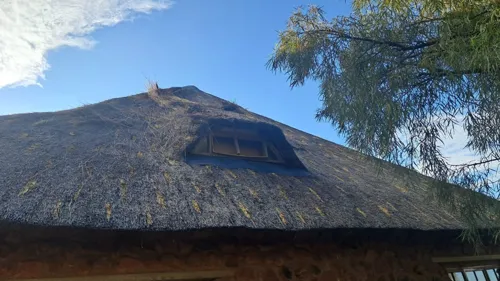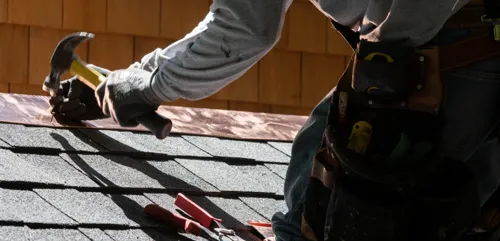Roof tile damage can be an alarming sight. Perhaps you’ve noticed cracked roof tiles or a suspicious leak. You worry about potential water damage and costly repairs. If this sounds familiar, you’ve come to the right place. In this article, we’ll explain why roof tiles get damaged, what happens if you ignore them, and how to fix them to protect your home’s integrity.

Why roof tile damage occurs: causes and concerns
There are several reasons behind roof tile damage, including:
- Weather extremes: Sudden temperature changes and harsh storms lead to cracked tiles, particularly clay or terracotta tiles that aren’t sealed properly.
- Damaged flashing: Flashing that is bent or rusted can expose underlying areas, leaving roof tiles vulnerable to water damage.
- Improper installation: If tiles are installed without the proper overlap, water penetrates easily, resulting in hidden leaks.
- Age and wear: Over time, all roof tiles weaken, making them more prone to chips and cracks.
- Foot traffic: Walking on a tile roof—especially near ridges or intersections—increases the chance of breakage.
If left unchecked, even a seemingly minor chip or crack can worsen. When moisture seeps beneath those damaged roof tiles, what starts as small roof damage often spreads, leading to much bigger problems over time.
The impact of neglected roof tile damage
- Water leaks: Even tiny cracks allow moisture inside, risking mould, rot, and structural weakening.
- Energy inefficiency: Gaps in your roofing let heat escape in winter and enter in summer, boosting your energy bills.
- Costly repairs: Untended roof tile damage can escalate to major roof repair, which is far pricier and time-consuming.
- Decreased property value: Visible roof tile issues put potential buyers off, affecting your property’s resale value.
By acting early, you ensure reliable roof leak prevention and avoid both stress and expense down the line.
Practical roof tile repair solutions: from DIY fixes to professional help
1. Quick DIY checks
Before you undertake any major roof repair, inspect your tiles closely. From the ground look for chipped edges, cracked surfaces, or loose starts of damage. Avoid walking on the roof preferentially — even a small slip can make damage worse or endanger your safety.
2. Simple cracked tile repair
Tools and materials: Replacement tiles, pry bar, hammer, gloves, and sealant.
- Identify the damaged tile: Confirm the extent of the crack. If it’s minor, a sealant may do; if it’s extensive, replace the tile.
- Remove the old tile: Gently lift adjacent tiles using a pry bar, then carefully slide out the damaged tile.
- Install the new tile: Slide the new tile into position and secure it following the existing pattern. Ensure it’s flush with the roof plane to avoid water accumulations.
- Seal and check: Use a suitable roof sealant if needed, then inspect for any missed cracks.
Potential pitfalls: Be mindful of brittle flashing or hidden cracks. Working in damp weather can also make the roof slippery and dangerous.

3. Replacing damaged flashing
If you suspect water seepage around intersections or chimneys, the culprit might be damaged flashing. Removing old, corroded metal sheets and installing new flashing helps channel water straight off your roof rather than into your rafters. Make sure it’s properly nailed or sealed with waterproof caulk. This step can be tricky, so consider hiring a professional if you’re not comfortable on ladders or working with sheet metal.
4. Professional inspection for lingering issues
If your clay or terracotta roof tiles don’t sit evenly, or you suspect structural damage, call in a professional. A trained roofer can spot small issues that might be unnoticeable to the untrained eye, preventing larger problems later. They have the right gear, from scaffolding to safety harnesses, ensuring thorough checks without risking injury.
When to call a professional
- Extensive water stains or severe leaks
- Multiple cracked roof tiles across the entire surface
- Evidence of mould and rot in the roof trusses
- Damaged flashing along chimneys and vents
- Major tile intersections or ridge problems that keep recurring
5. Professional roof restoration
For large-scale repairs, an expert team might suggest a partial or full roof restoration. This could include removing old or damaged tiles, replacing underlayment and flashing, upgrading insulation, and resetting perfectly aligned new or reconditioned tiles. Professionals offer peace of mind, experience, quality materials, and often a workmanship guarantee. It ensures your roof repair stands strong against future storms and weather extremes.

Better peace of mind for your roof
A small roof tile issue can quickly spiral into a major headache. The key to avoiding bigger trouble is prompt action, from quick DIY inspections to professional roof repair when necessary. Whether you’re worried about a single cracked tile or more extensive tile roof issues, it’s vital to fix them fast so you can prevent leaks, dampness, and long-term damage.







